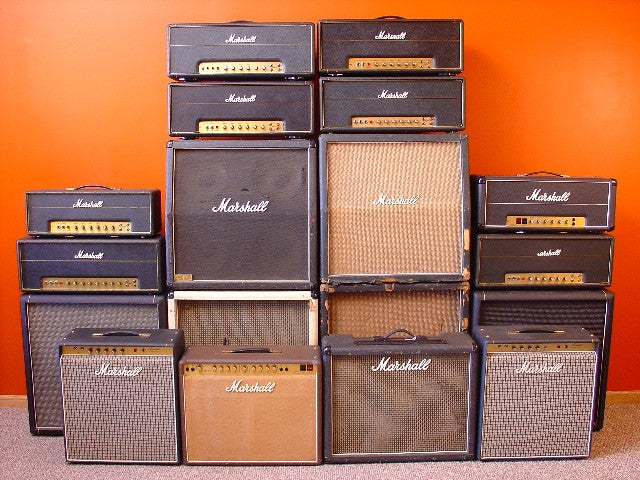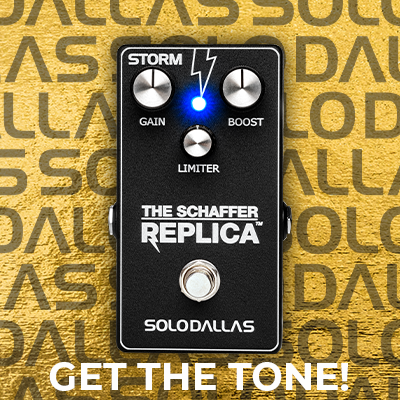This is my first article here at Solodallas.com. I hope this can be useful to all of you who are interested in buying old Marshall amps.
(SoloDallas’ note: it is with pleasure that I introduce to you our already very well known friend Andrè, aka Jaiminho Pagina: he’s now a contributor of SoloDallas.net!)
(NOTE – I did some updates at the 2203/ 2204 section of the article ~JaiminhoPagina)
Before starting, I must warn you that acquiring vintage gear can be really risky. You can end up buying something that is not what you expected or even something that is damaged or modded beyond repair. So, always keep your eyes open for “fishy” deals, look for information, and always ask for high definition photos (especially from the interior of the amps – the circuit, the tubes and transformers) to make sure everything is right. If you don’t have much experience (myself included, to be honest :P), I recommend asking help from the members here of the community. Post a link of the desired amp on the “Ebay Watch Post”, so we can help analyzing it.
In this article, I’ll try to cover the more “desirable” Marshall amps that were built since 1962 up to the JCM800 series, wich most consider to be the “last” great Marshalls produced (That until Marshall released the Vintage Modern series. These amps are really great!).
I’ll concentrate on “how they sound”, “how they look like” and also “how to tell them apart”. I will also try to give examples of where they were used..
So, here we go. I hope you like it 🙂
Understanding Marshall model numbers
One of the most confusing things concerning these vintage amps are the model numbers. I’ll write down the most important ones and what they mean.
- 2245 – Although I believe the first JTM-45s didn’t really have a model number, this is the code that is related to them on Marshall’s website.
- 1987 – Any Marshall Lead circuit (50w, non-MV)
- 1986 – Any Marshall Bass circuit (50w, non-MV)
- 1959 – Any Marshall Super Lead circuit (100w, non-MV)
- 1992 – Any Marshall Super Bass circuit (100w, non-MV)
- 1963 – Any Marshall Super PA circuit (50w, non-MV)
- 1968 – Any Marshall Super PA circuit (100w, non-MV)
- 2204 – Any Marshall Master Model circuit (50w, MV)
- 2203 – Any Marshall Master Model circuit (100w, MV )
These are just a few of the thousands of codes that Marshall came up with for their amps. I won’t write the rest because it may confuse you even more. So, let’s stick to those for a while.
It’s important to note that, for example, a 1959 amp has nothing to do with the year 1959. Why they chose those numbers then? I don’t know.
More important notes:
- The addition of a T at the end of the code refers to a Tremolo amp.
- The addition of a S at the end of the code refers to a smaller version of the head, made to fit with a 4X10 cab – This only aplies to the 2204S head from the JCM series.
- Combo versions of the amps always had a special code attributed to them (for example, the combo version of the JMP 2204 was the 2104).
- The 1959S and the 1987S are the codes for the first “Plexi” reissues, made in 1988.
The JTM Era: 1962 – 1965
The JTM-45
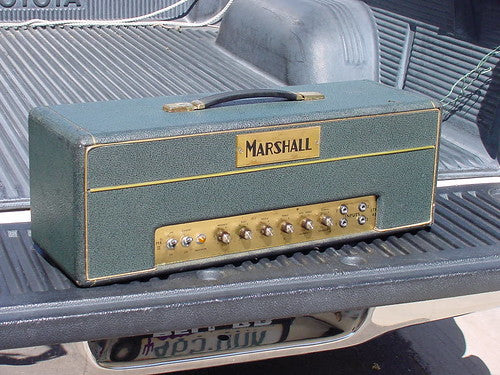
with “block” logo
The first Marshall ever made. It was basically a copy of the 1959 Fender Bassman. It had ECC83 (a.k.a. 12ax7) pre-amp tubes and a GZ34 rectifier tube. The first amps had 5881 power tubes. They were changed to KT66 shortly after. It was made as a head and as a combo (known as the “Bluesbreaker” combo). There were many cosmetic changes on the first years until it finally got the “Classic Marshall Look” by 1964.
The front panel has “Presence”, “Bass”, “Middle” and “Treble” controls, as well as 2 volumes and 4 inputs. In 1965, the plexiglass faceplates were introduced. This is the reason why Marshalls of this early era (up to 1968) are known as “Plexis”.
The sound of this amplifier is “creamy” and “warm”. I would say “crispy” too. This amp is more suited for blues players, with a smoother sound.
Eric Clapton used a JTM-45 combo on the legendary Blues Breakers with Eric Clapton “Beano” album (Now you know why this amp was called “Bluesbreaker” :P) He used his Les Paul through the Normal Channel of the amp. He discovered that, by playing really loud, it would start to “break up”. It was something really new. It changed music forever. The then “horrible” distorted and saturated sound turned into what we know today as the “rock tone” (maybe not yet… But we will get there).
Another example of this amp can be heard on AC/DC’s Ballbreaker album. Free’s debut album Tons of Sobs was probably recorded with a JTM-45 too.
The transition to the JMP: 1965 – 1967
This is a confusing era, with lots of changes and new models. So, I’ll try to explain it the best I can. 😛 The transitition from the JTM to the JMP amps happened, in my view, with three steps. The first one was the creation of the first 100w amp.
The JTM-45/ 100 (JTM-100)

Pete Townshend and John Entwistle of The Who needed amps that could overpower the noisy and energetic crowds.
Marshall then “hot-rodded” the JTM-45 using four KT66 and two 50w output transformers to handle the extra wattage. A larger headbox was also used. The result was the JTM-45/100 (JTM-100, for short). With more power tubes, the amp had more headroom, a tighter bass response and more definition. It was the first Marshall with a solid state rectifier.
Another player that acquired some of those was Eric Clapton, who used them to tour with Cream.
The change to EL-34s
The change to EL-34 tubes resulted in the increase of power. The name of the amps was also changed. This is when the confusing model numbers started being used I believe.
The JTM-45 was now called Marshall Lead 50w #1987.
This amp had a more edgy sound than the JTM-45, due to the EL-34s. But it also had the characteristic smoothness of the tube rectifier. For this reason, this amp is known today as the JTM-50.
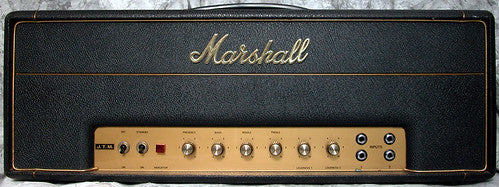
JTM-50
I’m not sure what recordings this amp was responsible for. But Fil’s Metro is a reproduction of this very same amp, so you might be familiar with it by now.
Please note the “Black Flag” JTM marking that was used at that time.
The JTM-100, now with four EL-34s too, also gained a proper 100w transformer. The name? It was called Marshall Super Lead 100w #1959 (Although they still didn’t have the “JMP” mark on the front, In my view, this amps are already into the JMP territory, because they have all of the JMP characteristics).

This is a photo of a JTM-45/100, but it’s the same headbox used for the early Super Leads

Back of a Marshall Super Lead
I think you are all familiar with this amp. Many consider it to be the ultimate rock amp. It’s indeed, a lengend on it’s own. This early “Plexi” versions (up to 1968) are really articulate and have a real nice “roar”. If you want to hear this amp, listen to any Free live performance. Paul Kossoff was the man who really knew how to use these. When I listen to the Free Live! album, and I hear the sweet tone of that Les Paul through his Super Leads, I feel I’m in “tone heaven” 😛
The change to the solid state rectifier
By late 1966 – early 1967, Marshall stopped using the GZ34 tube rectifier in all the models and started using a solid state rectifier instead.
The JTM50 now definetly turned into the JMP incarnation of the 1987 model, although the “formal” name ramained the same.
This amp is basically the 50w version of the Super Lead, so the sound is really similar to it’s “big brother”.
New Models of the “Transition Era”
While all those changes happened, new models started being developed to expand Marshall’s catalog. Here are some of them:
Marshall Bass and Super Bass

Back of a Marshall Super Bass
The Marshall Bass 50w #1986 and the Marshall Super Bass 100w #1992 appeared after the change to the EL-34 tubes. Related to the #1987 and the #1959 respectively, they were designed for bass players. But many guitarrists also decided to try those and they found out that they could get really interesting tones with them. They were a bit smoother and had a tad less gain than their Lead counter-parts. They can easily be converted into Lead circuits as well. So, if you find one for a good price, grab it 🙂
It used the same headbox as the Super Lead. Front panel was also identical.
Marshall Super PA

A damaged Marshall Super PA
The Marshall Super PA 50w #1963 and the Marshall Super PA 100w #1968 amps may scare you a bit when you look at them. These amps had two “sections” (The most common thing to do was to set one section to Lead specs and the other one to Bass specs). With a standard eq (presence, bass, middle, treble), a total of 8 inputs (4 for each “section”) and 4 volumes, this thing is a real Frankstein monster.
So… How does it sound like? The Lead section sound like a Lead circuit. The Bass section sounds like a Bass circuit… duuuhhh 😛
This is a really underrated amp. It is just as good as the other (probably even more versatile), but the “weird looks” probably scare people a bit and they think this is not a good amp. For that reason, these amps are less expensive and are a really great deal (if in good condition, of course).
Ah… Did I mention that Free used a lot of Marshall Super PAs on stage? 😛
Marshall Major

The back of a Marshall Major. Note the 4 KT88 tubes. The extra knob probably is a Master Volume mod.
If you thought a Marshall Super Lead was already too loud. Stay away from this thing. This is a JMP on steroids. It’s 200W of pure loudness
The Marshall Major 200w has a different circuit than its “little brothers”: the pre-amp has two ECC83s, but the third tube (the “driver tube”) is an ECC82 (a.k.a. 12au7). The power section has four KT88 tubes. These amps were not only stupidly loud, but also really really clean.
Ritchie Blackmore was a famous user of the Major, but they were heavily modded at the Marshall factory (as said in an interview) and later by a man called John Dawk. Blackmore’s amps had extra power tubes, making it even more powerful, as well as extra gain stages. Don’t ask how that’s even possible. I have no clue either.
These amps also CAN NOT TAKE ANY KIND OF BOOST OR OVERDRIVE. Its nicknamed “Smoke On The Water Effect”. These amps would blow because they were already working at critical point without anything, so if you plugged something to make them run even hotter… well…
This is one of the reasons why the Major was discontinued in 1974.
Marshall Tremolo amps

Marshall Super Tremolo. Note: 8 knobs instead of 6
These amps had an extra 12ax7 tube for the “tremolo” effect. They are easy to tell apart because the two extra knobs (“speed” and “intensity”) on the front panel.
These amps weren’t much popular and were discontinued in 1973.
On a side note, a faulty Marshall Super Lead #1959T was modified by Tim Caswell (he used the extra 12ax7 as another gain stage on the pre-amp), and it became the legendary #39 of SIR studios in California, USA. The amp was desired by every musician that rented it. SIR studios declined all the offers they received for it. Then, this amp was used on the rehearsal sessions of Guns ‘n’ Roses’ Appettite for Destruction album. Because of rumors that Slash was going to steal the amp (and legend says he did it!), SIR studios switched amps, and Slash ended up “renting” #36 instead: a late 70’s JMP, also modified like #39 (He didn’t notice the difference?). AFD was recorded with this amp. Then, a misinformed roadie returned it a year later (and was probably fired afterwards). Both amps never were seen again. (Creepy, huh? XD)
The “Plexi” JMP era: 1967 – 1969

Close-up of a “plexiglass” panel JMP
And now, we are oficially into the JMP era.
The first JMP marked amps came out around late 1967, although, as you saw, all of them already had JMP characteristics. So, it was more of a “brand” renewal.
An important note is that, by 1968, there were some changes on the circuits that made the amps more aggressive. All the models mentioned above are still being produced here.
The amplifiers that were shipped to America had an extra toggle, wich was the polarity switch. That happened until around 1976.
A notable user of these amps is a guy named Eddie. Yes: On Van Halen’s debut album, a 100% stock 1968 Marshall Super Lead #1959 was used. With a thing called variac, he was able to kind of “attenuate” the amp and obtain more gain.
Jimmy Page of Led Zeppelin is well know for his use of a 1959 Les Paul and Marshall Super Lead #1959 amps (Did you notice that both have 1959 on their name? Coincidence? :P). I’m not sure of the year his amps were made, but something tells me that they are from around this period (1968 or 1969) or maybe from the early Metal-Face years. Anyway… It’s said that his amps were modded to accept KT88 power tubes, boosting their power to 200w (and actually, he really told so on an interview in 1977), but the question is: When was it done? – My opinion is that maybe he did that around 1974, since his tone was a lot different in the 1975 tour, but, of course, I might be wrong. 😛
Malcolm Young said his favourite amp is an old Super Bass amp, probably from this period too (it could be an early Metal-Face as well).
The “Metal Face” JMP era: 1969 – 1976
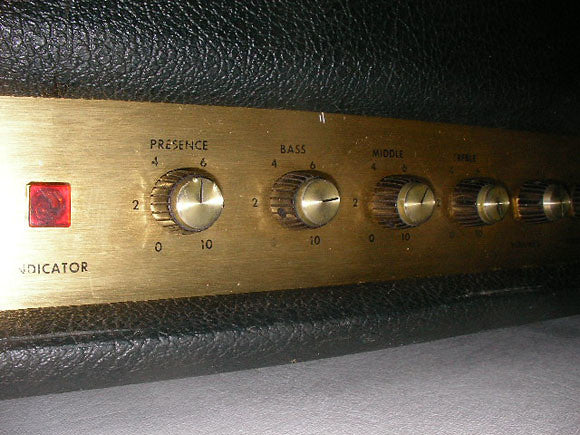
Close-up of a “Metal-Face” Marshall
In mid-1969, the plexiglass faceplates were replaced by brushed aluminium faceplates, hence the nickname “Metal-faces”.
This change didn’t affect the tone directly. What happened is that there were more changes in the components and the amps became even more aggressive: they were brighter and had a more drive than before. This was actually good for most guitar players, since they wanted more and more gain.
Another good side here is that amps made after 1970 doesn’t have so much collectible value as the early “Plexi” amps. These are probably the best oportunities to own a “Plexi style” circuit without spending a fortune (with some tweaks, they can be converted into the “smoother” late 60’s circuit).
It’s important to note that from 1972 onwards, Marshall amps that were shipped to America had 6550 power tubes, because american dealers said EL-34s were breaking too much often inside the warranty time.
There weren’t much changes afterwards. The only one that worth mentioning is the switch to PCB style assembly on late-1973. Did it affect the tone? I can’t really tell. It got worse? Definetly not. They are as reliable as the PTP Marshalls. You can read more about this here.
Another change (wich is not that important) is that now the 50w chassis were put in the same bigger style headbox as the 100w. So, the only way to tell them apart (besides the model written on the back, and the number of power tubes) is by looking at the top. If it has a top vent, then it’s a 100w. If it doesn’t, it’s a 50w.
Due to all the hype around the PCB, post-1973 Marshalls are even more accessible to us. 😀
AC/DC probably used Metal-Faces from this era to record High Voltage, TNT and Dirty Deeds Done Dirt Cheap, as well as live performances up to 1976 (Angus used to play his solos with the neck pickup a lot back then, probably because he coudn’t always play with his amps loud enough to get the desired overdrive).
The PA and Super PA heads were discontinued around 1975.
The Marshall Master Model
In 1976, Marshall decided to try something new. After receiving many complains, they decided to put a Master Volume on their amps. They used the #1959 and the #1987 as a base, removed the normal channel and added a pre-phase inverter master volume on it, so it was possible to have the pre-amp saturation at lower volumes. The panel of this model had only 2 inputs, standard eq section , a Pre-Amp and a Master Volume knobs. They called it Marshall Master Model 100w Lead #2203 and Marshall Master Model 50w Lead #2204. Did it work? Yes and no. Yes, it was possible to have pre-amp drive at low volumes, but since it was the power amp saturation that made Marshalls so great, guitar players complained that they couldn’t get enough “distortion” at lower volumes. So… Marshall had to come up with something to solve this problem…
UPDATE: It seems that the early versions of the 2203 (100w – with the old cosmetics) already had the cascaded pre-amp. Only the 2204 (50w) suffered from the lack of gain at low volumes.
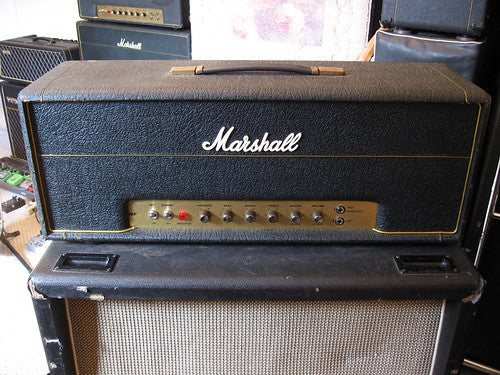
Early version of the JMP Master Model #2204 (no top vent = 50w)
The “Rocker Switch” JMP era: 1976 – 1981

1979 Marshall JMP Super Bass 100w #1992
So… Here we are. This is the part you wanted to see, right? All of you AC/DC gearheads (myself included! :P) here at the Solodallas classic rock comunity want to know more about the Late 70’s JMPs, don’t you? Well… I’ll do my best to let you satisfied! 😀
Around this time, Marshall decided to upgrade the cosmetics of their amps. They started using rocker style switches instead of the old toggle switches (yes. This is why I called it “Rocker Switch Era”. No pun intended), the “Marshall” logo was bigger and there was a thicker white binding on the corners, as well as under the logo. The only thing is: there were many parts left on stock and they had to use them! So, if you find a weird looking 1976 – 1977 JMP, it’s probably just because they were using some old parts to assemble them. By mid-1977, they were over and only new parts were used.

An example of a “mixed up” 1976 JMP: Notice the old style headbox and, at the same time, the thicker binding, the bigger logo and the rocker switches
Interestingly, the amps for the Canadian market kept the EL-34 tubes and the old toggle switches.
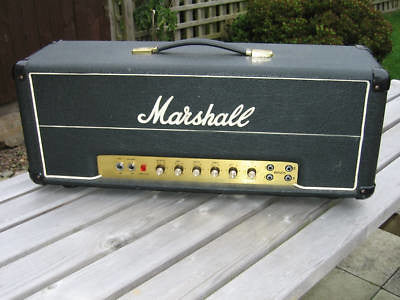
Canadian version of a late 70’s non-MV JMP
The “NEW” Marshall Master Model
While the sales of the non-MV volume amps continued steady and well, Marshall faced a serious problem with their new product: Most people didn’t like their Master Model amps (this refers only to the 2204) because there was no enough gain at lower volumes. It was a disaster: After 14 years selling non-MV amps, always relying on the power amp saturation, Marshall, the company that made the best RnR amps in the world suddenly had an amp with “no enough gain?”
And on late-1976 or early-1977 the magic happened… It was an instant success! You had a great overdriven tones at any volume (Of course, the louder it was, the better it would sound). It could also work as a “Plexi-style circuit”, by keeping the Master on 10 and working with the pre-amp volume. Of course, it also had a unique and distinctive voice.
NOTE:
A way to find out if a 2204 have the cascaded pre-amp or not is the Two Cables test.
Just get two cables and plug them into both inputs of the amp. Turn it on and put your hand on the other end of the cables to produce sound. Theorically, if you get sound only from one input, this means you have the cascaded circuit. If you get sound from both, you have a non-cascaded circuit.

Marshall JMP Master Model 50w #2204
In 1976, AC/DC launched the international version of the High Voltage album, wich actually was a mix of songs from the Australian High Voltage and TNT.
Marshall realized the potential of the new band and decided to sponsor them. When they got into the studio to record the Let There be Rock album, they already had brand new JMP “rocker switch” amps. So… what they used? MV or non-MV? The nasal and overdriven tone is unmistakable. They used the 2203/ 2204 Master Model heads extensively through the years. But also, they still were faithful to the old non-MV circuits So, they almost always mixed them on stage. Powerage, Highway to Hell, Back in Black… up to the Blow Up Your Video… all recorded with amps from this era. It’s hard to tell when they used what amp, but you can’t go wrong with these beasts.
Master Volume vs. non-Master Volume
But wait a minute… The old non-MV were still being made with the new cosmetics? Yes. They were. So, if you are looking for a late 70’s JMP, always look at the number of inputs so you don’t end up buying a Super Bass thinking you’ve just got a 2203! 😛
You can also look at the back. The model will be written there. So, just to make sure you won’t get yourself into trouble:
- 1959/ 1987/ 1992/ 1986 (non-MV): 4 inputs, 2 Volumes, Model of the amp written in block letters at the back.
- 2203/ 2204 (MV): 2 inputs, Pre-amp and Master Volume, Model of the amp in handwriting letter style at the back.
Anything different from that (3 inputs, extra knobs, etc) is a modded amp.

Example of the “block letter style” of a non-MV amp

Example of the “handwriting letter style” of a 2203/ 2204
EDIT: A new finding by user 06AngusSG
The two extra jacks that appear on this head are actually STOCK!
They are simply extra outputs. Here is what he found out:
“I started looking around right after I posted this (a little chat on the comments of this page regarding this same subject) and I believe I found the answer to confirm my thoughts. Here is a link to a Marshall forum page.
http://www.marshallforum.com/marshall-amps/23862-jmp-2203-speaker-outs.html
The guy here states that the U.S. variants
were required to have 4 holes to attain the proper UL rating.”
So, this means the U.S. export versions had 6550 tubes AND the two extra output jacks. All of them are useable.
Quite funny, isn’t it? 😛
The combo versions of these amps are really interesting too. So keep your eyes open for those as well.

50w JMP combo, a #2104 or a #2187
Around mid-1979 there was another minor circuit change. The result was, as you expected, more agressive amps. Also, the serial numbers started to be printed on the front panel, close to the switches.
In 1980 , Marshall started using a bigger logo. At this point, Marshall’s exclusive distribution contract with Rose Morris was expiring. Free from the contract, Marshall decided to, again, renew the whole Marshall line.

Larger logo used from 1980 – 1981 (And serial on the front panel)
The JCM800 era: 1981 – 1989

Marshall JCM800 100w #2203
In 1981, Marshall launched the JCM800 series. It was mostly a cosmetic change. But some claim that there were, again, small changes in the circuit. making these slightly more “modern” sounding amps. The “simple circuit” JCM800s are, in my view, still quite interesting amps. Let’s take a look at what we still have here.
A note here is that the name “JCM800” itself is, many times, related just to the 2203/ 2204 models, but the JCM800 was a series. This means there were other models. Altough rarer, the non-Master Volume amps (#1959/#1987/ #1992/ #1986) were still being made under the JCM name.
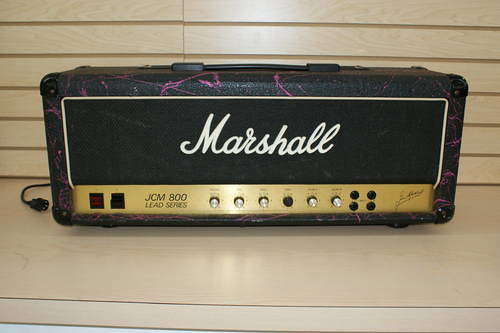
Marshall JCM800 Super Lead #1959 (non-MV)
Some amps with JMP style will surface there and there during the 80’s too. But they are basically a JCM800 in the old headbox.
Combo versions, are, again, really interesting. Try to look for the ones with the same circuits as the heads mentioned above.

Marshall JCM800 50w 1×12 combo #4010 (2204 circuit)
Well… Here we got to the end of the line. There were no new interesting “simple circuit” amps launched during this period.
A last important note: Avoid the JCM800 2203 and 2204 amps with “horizontal inputs” (made after 1986). The different position of the inputs meant a change in the circuit. This one was not a pleasant change and the result was a much more grainy and thin-sounding tone as they were turned up.

“horizontal input” JCM800 Master Volume. Not a really good deal
In 1989, the JCM800 line was over, and the high gain JCM900 era begun. 🙁
So… This is it. I hope you liked this…. “little” piece of Marshall’s history. 😀
Serial Numbers
Serial numbers are a great way to find the model/ year of the amp. Here is some info about them:
Prior to 1969, the amps don’t have serial numbers.
Model Code Explanation
A/ or /A 200 Watt
RI Reissue Series
S/ or S/A 50 Watt
SB/ or SB/A Super Bass – 100 Watt
SL/ or SL/A Super Lead – 100 Watt
SP/ Super PA
ST/ or ST/A Tremolo – 100 Watt
T/ or T/A Tremolo – 50 Watt
Date Code Year
A = 1969-70
C = 1971
D = 1972
E = 1973
F = 1974
G = 1975
H = 1976
J = 1977
K = 1978
L = 1979
M = 1980
N = 1981
P = 1982
R = 1983
S = 1984
T = 1985
U = 1986
V = 1987
W = 1988
X = 1989
Y = 1990
Z = 1991-92
Cheers! Thanks for reading! 🙂
Interesting links:
http://www.superiormusic.com/page024.html
http://www.legendarytones.com/marshallshoppers1.html
http://www.legendarytones.com/marshallshoppers2.html
http://www.legendarytones.com/claptonearly1.html
http://www.drtube.com/marshall.htm
…

